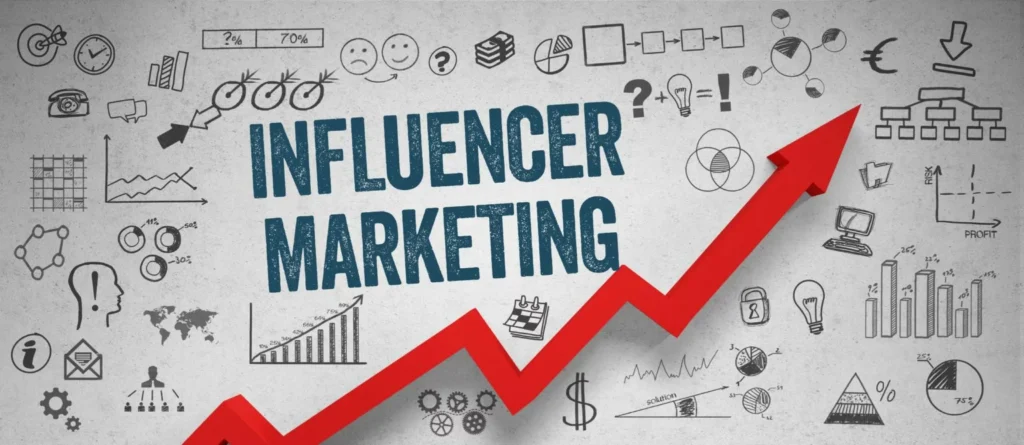Introduction
In today’s digital landscape, influencer marketing has become a powerful tool for brands looking to connect with their target audiences more authentically and engagingly. But what exactly is influencer marketing, and how can you leverage it to elevate your brand? This article will explore the concept of influencer marketing, delve into effective marketing strategies, and provide insights on how to make the most of this dynamic approach to brand promotion.

What Is Influencer Marketing?
Influencer marketing is a form of social media marketing that involves collaborating with individuals who have a significant following and influence over a specific target audience. These individuals, known as influencers, use their platforms to promote products, services, or brands in a way that resonates with their followers. The goal is to leverage the influencer’s credibility and reach to drive brand awareness, engagement, and ultimately, sales.
Influencers can vary widely in terms of their following and niche. They can be celebrities, industry experts, bloggers, or social media personalities. The key is that they can influence the purchasing decisions of their audience, making them valuable partners for brands looking to reach new customers in a more organic and trusted manner.
Why Is Influencer Marketing Effective?
The effectiveness of influencer marketing strategies lies in the trust that influencers have built with their followers. Unlike traditional advertising, which can often feel impersonal, influencer marketing feels more genuine because it comes from someone the audience already trusts. This trust translates into higher engagement rates, better brand loyalty, and increased conversion rates.
Key Influencer Marketing Strategies
To harness the power of influencer marketing, it’s essential to employ the right strategies. Here are some proven influencer marketing strategies to consider:
Identify the Right Influencers
The success of your influencer marketing campaign largely depends on choosing the right influencers. Look for influencers who align with your brand values, target audience, and marketing goals. Consider factors such as their follower demographics, engagement rates, and content style. Micro-influencers (those with smaller but highly engaged followings) can be just as effective, if not more so, than mega-influencers, especially for niche markets.
Set Clear Objectives
Before launching an influencer marketing campaign, define your objectives. Are you looking to increase brand awareness, drive traffic to your website, or boost sales? Clear objectives will help you measure the success of your campaign and ensure that both you and the influencer are aligned on what you hope to achieve.
Create Authentic Collaborations
The most successful influencer marketing campaigns are those that feel authentic and natural. Instead of dictating exactly what the influencer should say or do, collaborate with them to create content that aligns with both their brand and yours. Authenticity is key to maintaining the trust that the influencer has built with their audience.
Leverage Multiple Platforms
Influencers are often active on multiple social media platforms, such as Instagram, YouTube, TikTok, and Twitter. To maximize your reach, consider running campaigns across multiple platforms. Each platform has its unique audience and content style, so tailor your approach accordingly. For instance, Instagram is ideal for visually appealing content, while YouTube allows for more in-depth product reviews or tutorials.
Track and Measure Results
To determine the ROI of your influencer marketing strategies, it’s crucial to track and measure the results of your campaigns. Use analytics tools to monitor metrics such as engagement rates, website traffic, and sales conversions. This data will help you assess which influencers and strategies are most effective and allow you to refine your approach for future campaigns.
Types of Influencers
Understanding the different types of influencers can help you choose the best partners for your brand:
Mega-Influencers
Mega-influencers have over a million followers and are often celebrities or well-known personalities. While they offer extensive reach, their services can be costly, and their engagement rates may not always be as high as those of smaller influencers.
Macro-Influencers
Macro-influencers typically have between 100,000 and 1 million followers. They are often industry experts or thought leaders with a broad but targeted audience. Macro-influencers offer a balance between reach and engagement, making them a popular choice for many brands.
Micro-Influencers
Micro-influencers have between 10,000 and 100,000 followers. They often focus on specific niches and have highly engaged audiences. Micro-influencers are known for their authentic connections with their followers and can be a cost-effective option for brands looking to target specific markets.
Nano-Influencers
Nano-influencers have fewer than 10,000 followers but are highly influential within their communities. They are often regular people with a strong passion for a particular topic. Brands can work with nano-influencers to reach hyper-local or niche audiences.
How to Maximize Your Influencer Marketing ROI
To get the most out of your influencer marketing efforts, consider these additional strategies:
Use Affiliate Marketing
Integrate affiliate marketing into your influencer campaigns by providing influencers with unique discount codes or affiliate links. This not only incentivizes influencers to promote your products but also allows you to track sales directly attributed to their efforts.
Incorporate User-Generated Content
Encourage influencers to create content that their followers can participate in, such as challenges or hashtag campaigns. User-generated content (UGC) increases engagement and allows your brand to reach a wider audience through organic sharing.
Long-Term Partnerships
Instead of one-off campaigns, consider building long-term partnerships with influencers. Long-term collaborations can lead to stronger relationships with the influencer and their audience, resulting in more consistent and impactful brand messaging.
Conclusion
Influencer marketing has proven to be an effective way to connect with audiences in a more personal and engaging manner. By understanding what influencer marketing is and implementing the right strategies, you can elevate your brand and achieve your marketing goals. Whether you’re working with mega-influencers or nano-influencers, the key is to create authentic collaborations that resonate with your target audience and drive measurable results.
FAQ
What is influencer marketing?
Influencer marketing is a strategy where brands partner with influential individuals (influencers) who have a strong following on social media or other platforms to promote their products or services. Influencers use their credibility and reach to connect with their audience in a more personal and engaging way, helping brands increase visibility and drive conversions.
How do I choose the right influencer for my campaign?
To choose the right influencer, evaluate their audience demographics, engagement rates, and content style to ensure alignment with your brand’s values and target market. Consider influencers who have a genuine connection with their followers and whose content resonates with your brand’s message. Micro- and nano-influencers can be particularly effective for niche markets due to their high engagement levels.
What are the benefits of using influencer marketing?
Influencer marketing offers several benefits, including increased brand awareness, higher engagement rates, improved credibility and trust, and potential boosts in sales and conversions. By leveraging the influencer’s established relationship with their audience, brands can achieve more authentic and impactful marketing outcomes compared to traditional advertising methods.
How can I measure the effectiveness of an influencer marketing campaign?
Effectiveness can be measured by tracking key performance indicators (KPIs) such as engagement rates (likes, comments, shares), website traffic, conversion rates, and return on investment (ROI). Use analytics tools and tracking links to monitor these metrics and assess the overall impact of the campaign on your marketing goals.
What should be included in an influencer marketing contract?
An influencer marketing contract should include clear terms regarding deliverables (such as posts, videos, or reviews), deadlines, compensation, content guidelines, and usage rights. It should also outline expectations for disclosure of sponsored content and the process for handling any issues or modifications. A well-defined contract helps ensure a smooth collaboration and protects both parties involved.

Hello friends, my name is Shivam Kumar, and I am a writer, skilled in creating engaging, SEO-optimized content on online income and content creation since last two years. And I will be sharing this information form my blog.
1 thought on “Influencer Marketing Strategies”